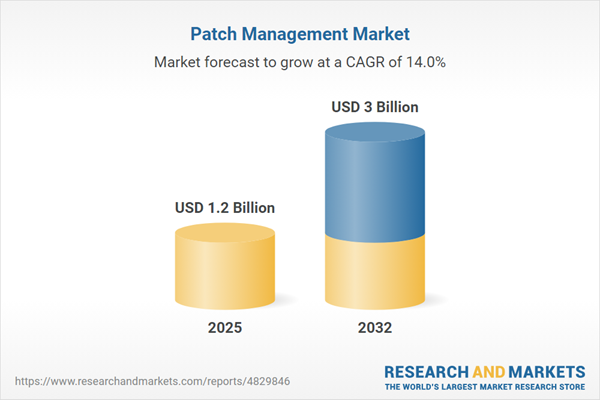Speak directly to the analyst to clarify any post sales queries you may have.
Patch management is a priority in today’s enterprise risk landscape, supporting leaders in securing digital operations, maintaining compliance, and aligning security processes with shifting organizational demands. Tailored solutions now enable robust protection without disrupting core business functions.
Patch Management Market Snapshot
The global patch management market is experiencing marked growth as organizations accelerate cloud adoption and refine cybersecurity strategies. In 2024, the market achieved USD 1.05 billion in value, driven by organizations adapting to stricter regulations and the need for seamless integration with agile infrastructures. With a projected CAGR of 13.97%, expansion is anticipated through enhanced automation and unified management tools. Market leaders are responding by delivering scalable, integrated platforms that serve the needs of multinational enterprises and rapidly evolving IT environments. As patch management solutions mature, they play an increasingly critical role in supporting digital transformation and addressing security in complex operational settings.
Scope & Segmentation
Contemporary patch management covers a broad spectrum of business and compliance needs, empowering senior decision-makers to customize their security approach. The following segmentation reflects the key market attributes that shape enterprise adoption strategies:
- Components: Consulting services, managed offerings, and specialized platforms allow organizations to implement cohesive patch processes, set security benchmarks, and integrate new capabilities efficiently.
- Platform Compatibility: Extending across Linux, Mac, and Windows, these tools create unified oversight, supporting both homogeneous and diverse IT environments without silos.
- Deployment Modes: Public cloud, private cloud, and on-premises options offer strategic flexibility, aligning patch management with business priorities and evolving mandates.
- Organization Size: Scalable solutions meet the needs of large enterprises and small to mid-sized businesses, accommodating varying resource levels and risk exposure.
- End-Use Industry: Financial services, healthcare, telecom, manufacturing, insurance, and retail demand custom-fit approaches to address sector-specific operational risks and compliance protocols.
- Regional Dynamics: Adoption rates and feature preferences reflect digital maturity, regulatory frameworks, and levels of process automation in the Americas, Europe, and Asia-Pacific.
- Key Companies: Major vendors—Microsoft, IBM, Ivanti, Broadcom, VMware, Zoho, SolarWinds, Qualys, Kaseya, and Automox—lead in developing integrated platforms and advancing automation and global support.
This segmentation strategy helps executives invest effectively, align cybersecurity efforts with industry needs, and maintain interoperability as technology and regulations evolve.
Key Takeaways: Strategic Insights for Patch Management
- Automation in patch management reduces risk and ensures organizations respond rapidly to vulnerabilities while keeping pace with emerging compliance requirements.
- Workflow automation in hybrid and multi-cloud environments enables IT teams to shift resources from maintenance to strategic innovation and modernization initiatives.
- Integrating patch management within DevOps pipelines enhances early detection and remediation, supporting secure continuous delivery across software assets.
- Zero trust security frameworks deliver end-to-end protection across distributed networks, which is essential for scaling and adapting as infrastructure needs change.
- Heavily regulated industries require advanced patch strategies for safeguarding sensitive assets in tandem with meeting new compliance demands and transparency obligations.
- Regional market trends show that North America emphasizes compliance, Europe drives automation initiatives, and the Asia-Pacific region focuses on AI to speed threat detection and response.
Tariff Impact
Fluctuating U.S. tariffs on technology hardware are prompting vendors to reinforce supply chains and build local alliances. As a result, businesses increasingly favor adaptable, cloud-based, and open-source patch management platforms to overcome procurement barriers and stay responsive to regulatory or tariff shifts.
Methodology & Data Sources
This analysis synthesizes feedback from enterprise IT and security leaders, proprietary market data, and real-time compliance tracking. Subject matter experts validate all insights to support well-informed, high-stakes decisions for senior executives.
Why This Report Matters
- Enables executives to develop resilient, scalable patch management frameworks in a fluid technological and regulatory ecosystem.
- Assists organizations in maximizing IT investment, reinforcing supplier relationships, and driving sustainable enterprise-wide security strategies.
- Supports operational continuity and agile risk management, equipping leadership teams to meet evolving business and compliance expectations.
Conclusion
Patch management is central to enterprise adaptability, enabling leaders to respond to changing security, technology, and compliance priorities with confidence and without interruption.
Additional Product Information:
- Purchase of this report includes 1 year online access with quarterly updates.
- This report can be updated on request. Please contact our Customer Experience team using the Ask a Question widget on our website.
Table of Contents
3. Executive Summary
4. Market Overview
7. Cumulative Impact of Artificial Intelligence 2025
Companies Mentioned
The companies profiled in this Patch Management market report include:- Microsoft Corporation
- International Business Machines Corporation
- Ivanti, Inc.
- Broadcom Inc.
- VMware, Inc.
- Zoho Corporation Private Limited
- SolarWinds Corporation
- Qualys, Inc.
- Kaseya Limited
- Automox, Inc.
Table Information
| Report Attribute | Details |
|---|---|
| No. of Pages | 189 |
| Published | October 2025 |
| Forecast Period | 2025 - 2032 |
| Estimated Market Value ( USD | $ 1.2 Billion |
| Forecasted Market Value ( USD | $ 3 Billion |
| Compound Annual Growth Rate | 13.9% |
| Regions Covered | Global |
| No. of Companies Mentioned | 11 |









